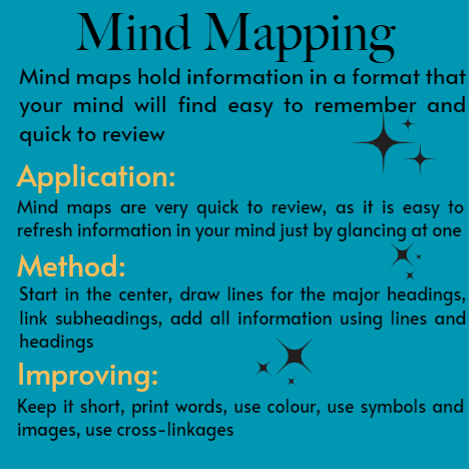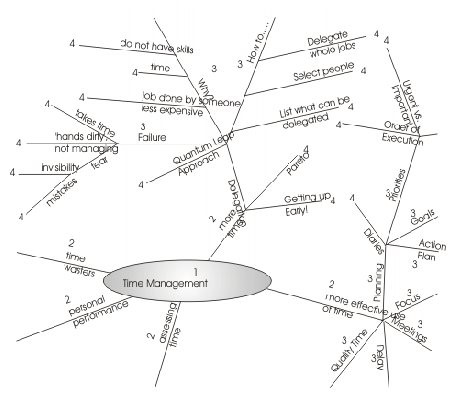
Click here to view a video that explains the mind-mapping process.
Mind mapping is a very powerful technique for improving the way you take notes. By using mind maps you show the structure of the subject and linkages between points as well as the raw facts contained in normal notes. Mind maps hold information in a format that your mind will find easy to remember and quick to review.
Mind maps abandon the list format of conventional note-taking. They do this in favour of a two-dimensional structure. A good mind map shows the ‘shape’ of the subject, the relative importance of individual points and the way in which one fact relates to the other.
Mind maps abandon the list format of conventional notes, often taking up one side of the paper. This helps you to make associations easily. If you find out more information after you have drawn the main mind map, then you can easily integrate it with little disruption.
Mind Map Application
Mind maps are also useful for:
- Summarising information.
- Consolidating information from different research sources.
- Thinking through complex problems, and
- Presenting information that shows the overall structure of your subject.
Mind maps can also be effective mnemonics. Remembering the shape and structure of a mind map can provide the cues necessary to remember the information within it. They engage much more of the brain in the processes of assimilating and connecting facts than conventional notes.
Example of a mind map on time management skills:

A complete mind map may have main topic lines radiating in all directions for the centre. Sub-topics and facts will branch off these, like branches and twigs from the trunk of the tree. You do not need to worry about the structure produced, as this will evolve of its own accord.
Mind Mapping Method
To make notes on a subject using a mind map, draw it in the following way:
- Draw a circle in the middle of a blank sheet of paper and write a project, goal, dream or idea in the centre of the circle.
- For the major subject headings, draw lines (spokes or branches) radiating out from the central circle. Label these lines with the subheadings.
- If you have another level of information belonging to the subheadings, draw these and link them to the subheadings
- For individual facts, thoughts or ideas draw lines out from the appropriate heading line and label them.
- Next, translate the ideas to an outline form and try to create some action steps based on your thinking.
- As you come across new information, link it into the mind map appropriately.
Improving Your Mind Maps
Your mind maps are your own property, once you understand how to make notes in the mind map format, you can develop your own conventions to take them further. The following suggestions may help to increase the effectiveness of your mind maps:
Use single words or simple phrases for information. Most words in normal writing are padding, as they ensure that facts are conveyed in the correct context and in a format that is pleasant to read. In your mind maps single strong words and meaningful phrases can convey the same meaning more potently. Excess words just clutter the mind map.
Print words. Joined-up or indistinct writing can be more difficult to read.
Use colour to separate different ideas. This will help you to separate ideas where necessary. It also helps you to visualise the mind map for recall. Colour also helps to show the organisation of the subjects.
Use symbols and images. Where a symbol or picture means something to you, use it. Pictures can help you to remember information more effectively than words.
Using cross-linkages. Information in one part of the mind map may relate to another part. Here you can draw in lines to show the cross-linkages. This helps you to see how one part of the subject affects another.